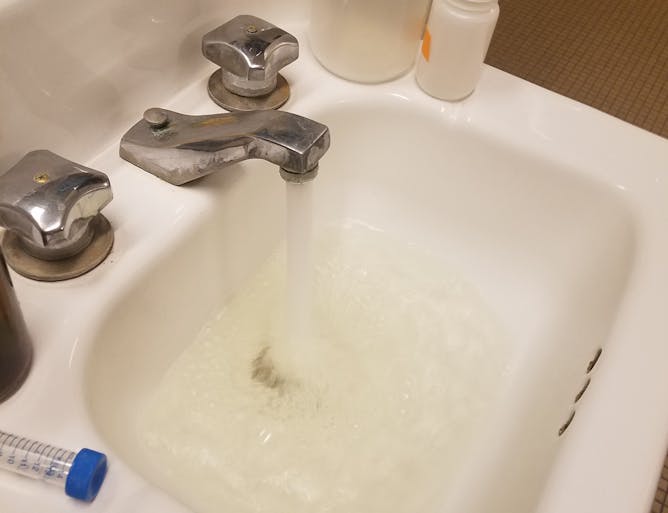|
While you’ve been following stay-at-home orders to protect public health, many of the buildings you normally use – offices, gyms, schools, shopping malls – have been unnaturally quiet. So has the water in their pipes. With no one running the taps or flushing the toilets, another health hazard may be growing inside.
A team of environment and ecological engineers from Purdue University and Virginia Tech is raising the alarm about waterborne risks in buildings as governors start announcing plans to send people back to work.
Also today:
|

Discolored water can be caused by heavy metals, such as iron or copper. Iron can also act as a nutrient for organisms to grow in the pipes.
Kyungyeon Ra/Purdue University
Caitlin R. Proctor, Purdue University; Andrew J. Whelton, Purdue University; William Rhoads, Virginia Tech
Office buildings have been left mostly empty for weeks amid the coronavirus pandemic, leaving standing water in pipes where harmful organisms can grow. What happens when those buildings reopen?
|
Economy + Business
|
-
Faizan Ali, University of South Florida; Cihan Cobanoglu, University of South Florida
A study of 2,000 travelers shows that nearly two-thirds will reduce their travel in the next year.
|
|
Politics + Society
|
-
Carlee Purdum, Texas A&M University
Incarcerated Americans have been tasked with washing hospital laundry, manufacturing protective equipment, disinfecting cleaning supplies and digging mass graves.
|
|
Ethics + Religion
|
-
Saleh Ahmed, Boise State University
COVID-19 is spreading quickly in Bangladesh. An outbreak in the refugee camps that house some 1 million Rohingya Muslims in cramped, unsanitary quarters would be calamitous.
|
|
Health
|
-
Michael Ahn, University of Massachusetts Boston
In addition to testing and special facilities for COVID-19 patients, the country's government-run tracking system allows the health care system to identify infected people and their contacts.
-
Siqian Shen, University of Michigan
Testing everyone for COVID-19 isn't realistic in a country the size of the US, but there are ways to design testing systems that can catch most of the cases.
-
Victoria Tutag Lehr, Wayne State University
Pharmacists are well positioned to provide communities with a lifesaving drug.
-
Fron Jackson-Webb, The Conversation
This weekly column by our team of international health editors highlights more of the recently published articles from The Conversation’s global network.
|
|
Education
|
-
Genevieve Shaker, IUPUI; William Plater, IUPUI
They're conducting research, accommodating testing facilities and turning dorms into quarters for medical professionals while also helping people muddle through hard ethical decisions.
-
Erika Bocknek, Wayne State University
A family therapist and childhood development expert encourages parents and others raising kids to focus on the 4 R's: routines, rules, relationships and rituals.
|
|
Science + Technology
|
-
Lionel Peter Robert Jr., University of Michigan
Pedestrians are wary of autonomous cars, but they trust traffic lights. Researchers suggest driverless cars could communicate directly with the signals to make their own actions more predictable.
|
|
From our international editions
|
-
Atif Kubursi, McMaster University
Alberta oil is the collateral damage of the oil war between Russia and Saudi Arabia, with COVID-19 launching an additional attack. The province's oil industry will struggle to recover.
-
Ahmed I Samatar, Macalester College
The composer, performer and poet was an artistic pioneer of lasting and distinctive gifts, and bottomless stamina. He gave us over 70 years of high-octane Somali musical mastery.
-
Jeremy Rossman, University of Kent
Some things about COVID-19 still don't add up.
|
|